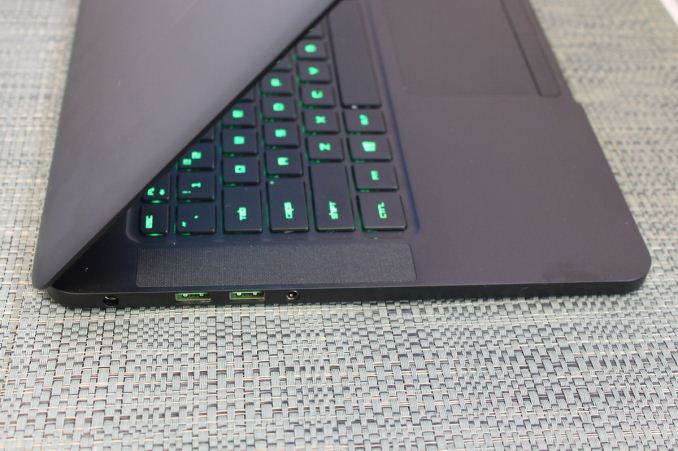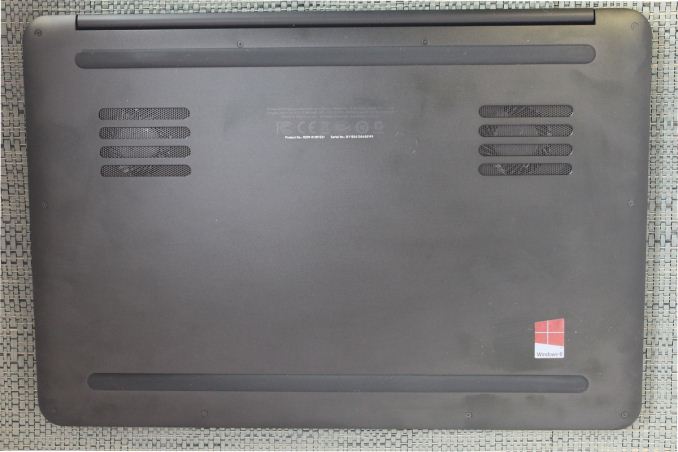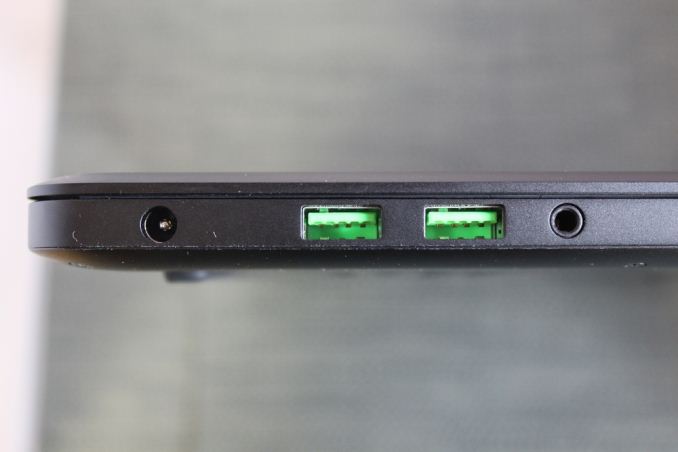The 2015 Razer Blade Review
by Brett Howse on February 11, 2015 2:00 PM EST- Posted in
- Laptops
- Razer
- Razer Blade
- Notebooks
- GTX970M
Design and Chassis
Internally, Razer outfitted the new Blade with a new CPU, GPU, and more system memory. But the chassis of the 2015 Blade has not changed at all. That is not really a bad thing though, since the Razer Blade already carried with it a fantastic CNC aluminum body. Comparisons are often made with the Retina MacBook Pro, and for good reason. Both are solid computers made of nicely crafted aluminum, and the overall dimensions of the Razer Blade are very similar to the 15 inch Retina MacBook Pro.
Also identical to the 2014 Blade is the matte black finish of the anodized aluminum, which feels great and resists fingerprints. The accents are all in “Razer Green” which is consistent across their product line. The USB accents, the keyboard backlighting, the power LED, and the Razer symbol on the back of the LCD are all represented in this shade.
The body of the Razer Blade is very strong, with no flexing or creaking to be had. The top of the lid keeps the two ridges running down the length of the display, which give a nice effect and likely increase rigidity.
The cooling system is also similar. Underneath the Razer Blade, there are two air intakes, which cool the CPU and GPU and push the heated air out into a vent between the display and the back of the laptop. This keeps the vent hidden from view, and makes for a great looking laptop, although the hot air can heat up the top part of the keyboard when the laptop is being worked hard.
We will see how well the cooling system handles the changes later in the review. It now has an additional ten watts of power to dissipate from the new CPU, and an even more powerful GPU, albeit one that is more power efficient as well.
The keyboard is also unchanged, and while it is a great keyboard, with good key travel, and nice feel, this is one area where Razer may have a chance to allow more customization. The “Razer Green” is adjustable as far as intensity, but it would be great to allow more user customization like the Razer Chroma keyboard, or at least color adjustability by the end user.
The trackpad on the Razer Blade is very large, and incredibly smooth. This is not a clickpad, and keeps the dedicated left and right click buttons under the trackpad. This is a layout that I prefer, but this is a preference and others may prefer the added real estate that a clickpad affords them. Regardless, it is a great trackpad. The smooth surface is very easy to move around on, and there were no issues that I found with two finger scrolling or other gestures.
Beside the keyboard is the front facing stereo speakers, and the sides of the device carry the three USB 3.0 ports, the 3.5 mm headset jack, HDMI 1.4 port, and the Kensington lock. An SD card slot would be nice, but is still lacking on the 2015 model. Those hoping for HDMI 2.0 are out of luck. In order to enable NVIDIA Optimus graphics switching, the output actually comes from the integrated GPU. Since Haswell only supports HDMI 1.4, the Razer Blade outputs on the HDMI 1.4b spec which limits the output to 3840x2160 at 30 Hz. Razer has told me that their data shows that more people prefer HDMI at this time, so they are sticking with this over DisplayPort for the external monitor connection.
Razer latops continue the elegant look of the black anodized aluminum, with no garish extras. Though it would be nice to allow for more user customization, it is difficult to fault Razer when they have been so consistent in their styling. The green perfectly matches their other products such as mice and headsets. Though they made no changes to the design of the laptop for 2015, there was little need to, since it was already very high quality, and with great components.















116 Comments
View All Comments
peterfares - Thursday, February 12, 2015 - link
There are lots of issues with HDMI 1.4 and 2560x1440. Most don't seem to be able to do 2560x1440 at 60Hz.http://www.notebookcheck.net/2560x1440-or-2560x160...
Most of these tests were able to get 55Hz after setting a custom resolution. I tried once to get 2560x1440 60Hz out of a laptop with only HDMI and I couldn't do it whereas my laptops with DisplayPort I can just plug in and it works.
close - Thursday, February 12, 2015 - link
It doesn't mimic anything. It's just a good design. It's like saying that all cars mimic the Ford Model T or something. It is a shame indeed that it lack some connectivity but if they actually did study the market and most of their potential customers wanted this it sounds reasonable enough.Jaisah - Thursday, September 3, 2015 - link
The body is almost identical to the rMBP and even the inside (fan positioning, soldered ram and location, speaker position, battery position) looks very similar to the rMPB. Maybe they didn't copy the rMBP but they certainly used it for inspiration :PUplink10 - Wednesday, February 11, 2015 - link
Why do people buy laptops with pricey gimped i7 CPUs, which cost the same as ungimped CPUs. They should make laptop with i5 desktop CPU which is much cheaper but it is not gimped and has the same performance.dragonsqrrl - Wednesday, February 11, 2015 - link
... and a far higher TDP.Oh and the answer to your question: TDP (probably package size as well)
anactoraaron - Wednesday, February 11, 2015 - link
What? Did you just start reading AT? They analyzed this not too long ago. http://www.anandtech.com/show/7287/analyzing-the-p... The higher end quad w/ht i7 laptop chips hold their own against any desktop i5... and at a much lower tdp. I'm not sure how you define gimpedUplink10 - Wednesday, February 11, 2015 - link
They could have higher clocks but also a little higher TDP.DanNeely - Thursday, February 12, 2015 - link
Because at about the same TDP the mobile i7 is faster than the desktop i5. The 47W i7-4720m has a base of 2.6ghz and can turbo to 3.4-3.6. The 45W i5-4690T only has a base of 2.5GHz and tops out at 3.1-3.5 for turbo. The overall TDP between the two chips is closer because the desktop chipset is 4.1W vs 2.7 for the mobile one. To get faster than a baseline mobile i7 you need to go to the 65W S series i5s. Normal laptops don't do that because an extra 20W of TDP will give much better returns most of the time with a faster GPU. You'll occasionally see a desktop CPU it in an 18-19" luggable; but other than in form factor those machines don't really qualify as laptops because they're too big, too heavy, and have too little battery life even at idle to be usable away from a desk.And even at that, in turbo mode the top end end mobile 47W i7-4980HQ is faster than the 88w desktop i5.
Uplink10 - Thursday, February 12, 2015 - link
I thought you generally have laptop plugged in when playing games. And when you do not play games for few hours, you can use a CPU with little higher TDP.Brett Howse - Thursday, February 12, 2015 - link
It's not about battery life. You have to get the heat out. On a desktop PC, the headsink and fan combo is 3-4 times thicker than the entire laptop. Next, look at the cooling solution on a GTX 970 desktop part and then look at the laptop.